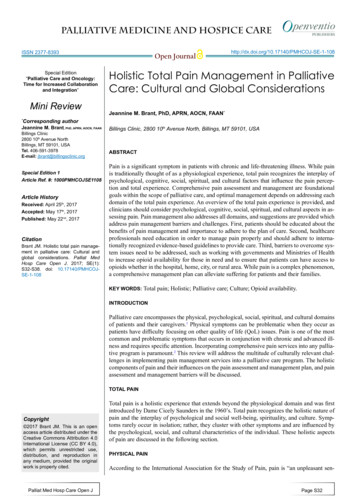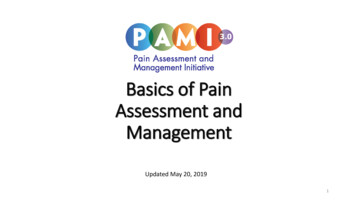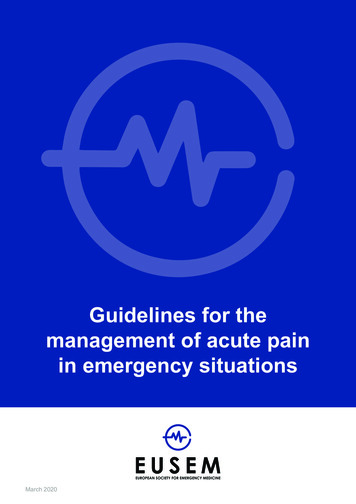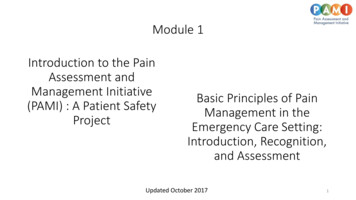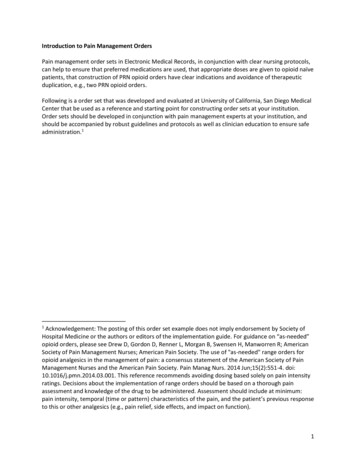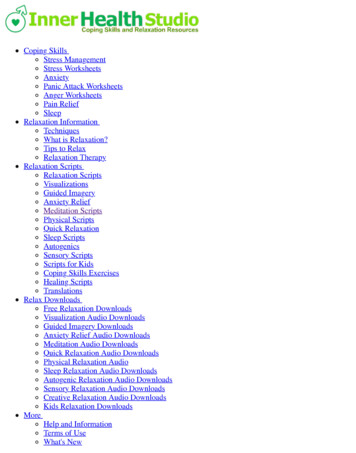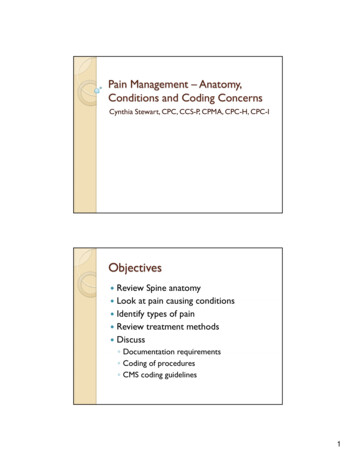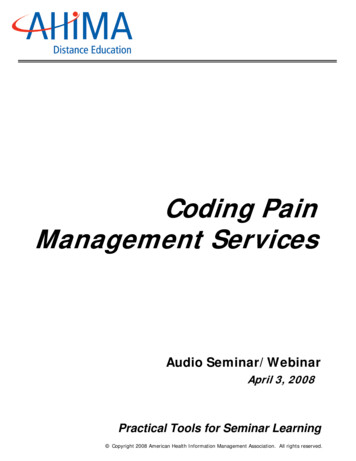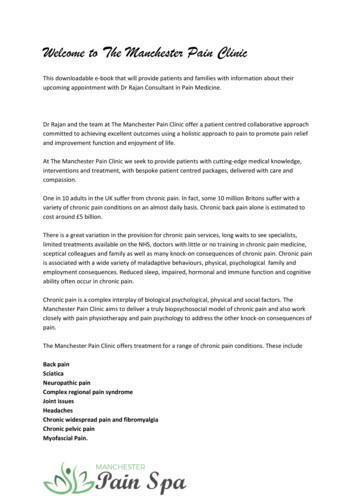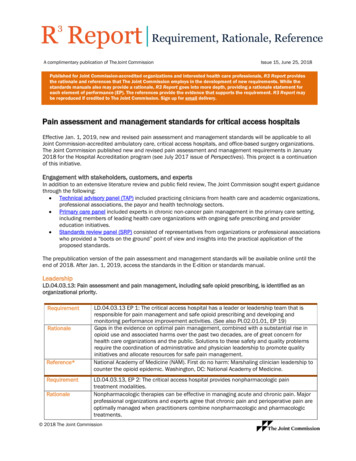
Transcription
A complimentary publication of The Joint CommissionIssue 15, June 25, 2018Published for Joint Commission-accredited organizations and interested health care professionals, R3 Report providesthe rationale and references that The Joint Commission employs in the development of new requirements. While thestandards manuals also may provide a rationale, R3 Report goes into more depth, providing a rationale statement foreach element of performance (EP). The references provide the evidence that supports the requirement. R3 Report maybe reproduced if credited to The Joint Commission. Sign up for email delivery.Pain assessment and management standards for critical access hospitalsEffective Jan. 1, 2019, new and revised pain assessment and management standards will be applicable to allJoint Commission-accredited ambulatory care, critical access hospitals, and office-based surgery organizations.The Joint Commission published new and revised pain assessment and management requirements in January2018 for the Hospital Accreditation program (see July 2017 issue of Perspectives). This project is a continuationof this initiative.Engagement with stakeholders, customers, and expertsIn addition to an extensive literature review and public field review, The Joint Commission sought expert guidancethrough the following: Technical advisory panel (TAP) included practicing clinicians from health care and academic organizations,professional associations, the payor and health technology sectors. Primary care panel included experts in chronic non-cancer pain management in the primary care setting,including members of leading health care organizations with ongoing safe prescribing and providereducation initiatives. Standards review panel (SRP) consisted of representatives from organizations or professional associationswho provided a “boots on the ground” point of view and insights into the practical application of theproposed standards.The prepublication version of the pain assessment and management standards will be available online until theend of 2018. After Jan. 1, 2019, access the standards in the E-dition or standards manual.LeadershipLD.04.03.13: Pain assessment and pain management, including safe opioid prescribing, is identified as anorganizational RationaleLD.04.03.13 EP 1: The critical access hospital has a leader or leadership team that isresponsible for pain management and safe opioid prescribing and developing andmonitoring performance improvement activities. (See also PI.02.01.01, EP 19)Gaps in the evidence on optimal pain management, combined with a substantial rise inopioid use and associated harms over the past two decades, are of great concern forhealth care organizations and the public. Solutions to these safety and quality problemsrequire the coordination of administrative and physician leadership to promote qualityinitiatives and allocate resources for safe pain management.National Academy of Medicine (NAM). First do no harm: Marshaling clinician leadership tocounter the opioid epidemic. Washington, DC: National Academy of Medicine.LD.04.03.13, EP 2: The critical access hospital provides nonpharmacologic paintreatment modalities.Nonpharmacologic therapies can be effective in managing acute and chronic pain. Majorprofessional organizations and experts agree that chronic pain and perioperative pain areoptimally managed when practitioners combine nonpharmacologic and pharmacologictreatments. 2018 The Joint Commission
Issue 15, June 25, 2018 Page 2Reference*Pain assessment and management standards for critical access hospitalsQaseem A, et al. Noninvasive treatments for acute, subacute, and chronic low back pain:A clinical practice guideline from the American College of Physicians. Annals of InternalMedicine. 2017;166(7):514-30.Skelly AC, et al. Noninvasive Nonpharmacological Treatment for Chronic Pain: ASystematic Review. Comparative Effectiveness Review No. 209. (Prepared by the PacificNorthwest Evidence-based Practice Center under Contract No. 290-2015-00009-I.) AHRQPublication No 18-EHC013-EF. Rockville, MD: Agency for Healthcare Research andQuality; June 2018.Nahin RL, et al. Evidence-based evaluation of complementary health approaches for painmanagement in the United States. Mayo Clinic Proceedings. 2016;91(9):1292-1306.Elsevier.Tick H, et al. Evidence-based nonpharmacologic strategies for comprehensive pain care.The Consortium Pain Task Force White Paper.Dowell D, et al. CDC Guideline for Prescribing Opioids for Chronic Pain—United States,2016. Morbidity and Mortality Weekly Report Recomm Rep. 2016;65(No. RR-1):1-49. doi:10.15585/mmwr.rr6501e1.Chou R, et al. Management of Postoperative Pain: A Clinical Practice Guideline from theAmerican Pain Society, the American Society of Regional Anesthesia and Pain Medicine,and the American Society of Anesthesiologists' Committee on Regional Anesthesia,Executive Committee, and Administrative Council. The Journal of Pain. 04.03.13, EP 3: The critical access hospital provides staff and licensed independentpractitioners with educational resources and programs to improve pain assessment, painmanagement, and the safe use of opioid medications based on the identified needs of itspatient population.Provider competence is stressed in clinical practice guidelines, regulations, and byexperts in the field. Providers are expected to be knowledgeable about multiple modalitiesof pain treatment, early identification and prevention of harms of opioid therapy, andmanagement of patients with complex needs. However, providers report insufficienttraining in pain management and opioid prescribing. The critical access hospital canincrease provider competence in pain management by providing access to effectiveeducation resources.Mostofian F, et al. Changing physician behavior: What works? The American Journal ofManaged Care. 2015;21(1):75-84.Alford DP, et al. SCOPE of pain: An evaluation of an opioid risk evaluation and mitigationstrategy continuing education program. Pain Medicine. 2016;17(1):52-63.RequirementLD.04.03.13, EP 4: The critical access hospital provides information to staff and licensedindependent practitioners on available services for consultation and referral of patientswith complex pain management needs. 2018 The Joint Commission
Issue 15, June 25, 2018 Page 3Pain assessment and management standards for critical access hospitalsRationaleMany patients in hospital and ambulatory settings have complex pain management needsand require multidisciplinary care. Access to specialists through consultation, referral, oruse of in-house experts reflects best practice. For example, consultation or referral to apain specialist is advised when it is necessary to develop a perioperative painmanagement plan for the patient with opioid tolerance or a history of substance abuse.Cost, lack of transportation, and low availability of services may hinder the use ofnonpharmacologic treatments. A barrier also could be the provider’s limited knowledgeabout available networks of nonpharmacologic care providers in the community. Criticalaccess hospital leaders can support access by providing information about localresources for patient referral.Reference*Chou R, et al. Management of postoperative pain: A clinical practice guideline from theAmerican Pain Society, the American Society of Regional Anesthesia and Pain Medicine,and the American Society of Anesthesiologists' Committee on Regional Anesthesia,Executive Committee, and Administrative Council. The Journal of Pain. 2016;17(2):13157.RequirementLD.04.03.13, EP 5: The critical access hospital identifies opioid treatment programs thatcan be used for patient referrals.When a patient is suspected of having an opioid use disorder, clinicians need informationfor referring him or her for opioid use disorder treatment. Critical access hospitalleadership should identify up-to-date resources. The U.S. Substance Abuse and MentalHealth Services Administration (SAMHSA) website provides a directory of opioid treatmentprograms and related provider resources.RationaleResourcesU.S. Substance Abuse and Mental Health Services Administration (SAMHSA) Directory ofOpioid Treatment ProgramsRequirementLD.04.03.13, EP 6: The critical access hospital facilitates practitioner and pharmacistaccess to the Prescription Drug Monitoring Program databases.Note: This element of performance is applicable in any state that has a Prescription DrugMonitoring Program database, whether querying is voluntary or is mandated by stateregulations for all patients prescribed opioids.Prescription Drug Monitoring Programs (PDMPs) aggregate prescribing and dispensingdata submitted by pharmacies and dispensing practitioners. When used together withother assessment strategies and tools, PDMPs can assist providers in preventing misuseand diversion of prescription medications. A link on the homepage of the electronic healthrecord (EHR) to all relevant PDMPs in the geographic areas served by the organizationwould facilitate access. The Joint Commission does not mandate that organizations usePDMPs prior to prescribing an opioid because of the limited availability of currentdatabases in many locations. However, some states (e.g., Massachusetts) require use ofPDMPs prior to prescribing an opioid; critical access hospitals will be assessed oncompliance with state law.Substance Abuse and Mental Health Services Administration (SAMHSA). Prescription drugmonitoring programs: A guide for healthcare providers.RationaleReference*The Pew Charitable Trusts. Prescription drug monitoring programs: Evidence-basedpractices to optimize prescriber use 2016.RequirementLD.04.03.13, EP 7: Critical access hospital leadership works with its clinical staff toidentify and acquire the equipment needed to monitor patients who are at high risk foradverse outcomes from opioid treatment. (See also PC.01.02.07, EP 6) 2018 The Joint Commission
Issue 15, June 25, 2018 Page 4RationaleReference*Pain assessment and management standards for critical access hospitalsThe most dangerous adverse effect of opioid analgesics is respiratory depression, andmonitoring for respiratory depression is sometimes appropriate. However, there are nocontrolled trials of monitoring to help determine the optimal strategy. Therefore, thisdecision should be left to the treating clinical team. The leadership team should work withclinician leaders to ensure equipment is available to monitor patients deemed highest risk(e.g., patients with sleep apnea, those receiving continuous intravenous opioids, or thoseon supplemental oxygen).Chung F, et al. Society of Anesthesia and Sleep Medicine Guidelines on PreoperativeScreening and Assessment of Adult Patients with Obstructive Sleep Apnea. Anesthesia &Analgesia. 2016;123(2):452.Lam KK, et al. Obstructive sleep apnea, pain, and opioids: Is the riddle solved? CurrentOpinion in Anaesthesiology. 2016;29(1):134.Lam T, et al. Continuous pulse oximetry and capnography monitoring for postoperativerespiratory depression and adverse events: A systematic review and meta-analysis.Anesthesia & Analgesia. 2017;125(6):2019-29.Medical StaffMS.05.01.01: The organized medical staff has a leadership role in organization performance improvementactivities to improve patient safety and the quality of care, treatment, and , EP 18: The medical staff is actively involved in pain assessment, painmanagement, and safe opioid prescribing through the following:- Participating in the establishment of protocols and quality metrics- Reviewing performance improvement dataThe medical staff have responsibility for organizationwide pain management and shouldplay a significant role in defining organizational management and prescribing practices, inaddition to relevant quality improvement metrics.National Academy of Medicine (NAM). First do no harm: Marshaling clinician leadership tocounter the opioid epidemic. Washington, DC: National Academy of Medicine.Provision of Care, Treatment, and ServicesPC.01.02.07: The critical access hospital assesses and manages the patient’s pain and minimizes the risksassociated with treatment.RequirementRationalePC.01.02.07, EP 1: The critical access hospital has defined criteria to screen, assess, andreassess pain that are consistent with the patient’s age, condition, and ability tounderstand.Critical access hospitals need to develop systems for pain screening and assessment inorder to support appropriate individualized pain treatment and perioperative painmanagement. The hospital is responsible for ensuring that appropriate screening andassessment tools are readily available and used appropriately. The tools required toadequately assess pain may differ depending on a patient’s age, condition, ability tounderstand, and whether pain is acute or chronic. For example, chronic pain generallyrequires more extensive patient assessment, including various domains of physical andfunctional impairment. 2018 The Joint Commission
Issue 15, June 25, 2018 Page 5Reference*Pain assessment and management standards for critical access hospitalsMiller RM and Kaiser RS. Psychological characteristics of chronic pain: A review of currentevidence and assessment tools to enhance treatment. Current Pain and HeadacheReports. 2018;22(3):22.Reid MC, et al. Management of chronic pain in older adults. British Medical Journal.2015;350(7995):1-0.Stanos S, et al. Rethinking chronic pain in a primary care setting. Postgraduate Medicine.2016;128(5):502-15.Tobias JD. Acute pain management in infants and children—Part 1: Pain pathways, painassessment, and outpatient pain management. Pediatric Annals. 2014;43(7):e163-8.Core Curriculum for Pain Management Nursing, Third Edition. (Eds. M. Czarnecki & H.Turner). Elsevier, onaleReference*PC.01.02.07, EP 2: The critical access hospital screens patients for pain duringemergency department visits and at the time of admission.Barriers to pain assessment exist, including provider, healthcare system, and patientrelated barriers. Screening patients for pain at the time of admission helps in painidentification and treatment.Core Curriculum for Pain Management Nursing, Third Edition. (Eds. M. Czarnecki & H.Turner). Elsevier, 2018.PC.01.02.07, EP 3: The critical access hospital treats the patient’s pain or refers thepatient for treatment.Note: Treatment strategies for pain include nonpharmacologic, pharmacologic, or acombination of approaches.Referral may be necessary for patients who need more extensive assessment or requiretreatments and monitoring that exceed the clinical expertise and capabilities of theindividual provider. This may include patients with complex pain managementrequirements, pediatric patients with chronic nonmalignant pain disorders, or patientswith advanced perioperative needs related to opioid tolerance.Becker WC, et al. Evaluation of an integrated, multidisciplinary program to address unsafeuse of opioids prescribed for pain. Pain Medicine. 2017:pnx041.Chou R, et al. Management of postoperative pain: A clinical practice guideline from theAmerican Pain Society, the American Society of Regional Anesthesia and Pain Medicine,and the American Society of Anesthesiologists' Committee on Regional Anesthesia,Executive Committee, and Administrative Council. The Journal of Pain. 2016;17(2):13157.Palermo T, et al. Assessment and management of children with chronic pain. AmericanPain Society, 2012;4.RequirementRationalePC.01.02.07, EP 4: The critical access hospital develops a pain treatment plan based onevidence-based practices and the patient’s clinical condition, past medical history, andpain management goals.Differences in the experience of acute or chronic pain may be caused by painpathophysiology, risk factors, comorbidities, and psychosocial characteristics. Theseindividual variations support an individualized model of pain management, as well asresponsible transition of care across care settings to support ongoing care needs. In someinstances, an individualized approach to treatment and monitoring is necessary and safebecause insufficient clinical guidance exists in areas such as evidence on postoperativeopioid tapering protocols. 2018 The Joint Commission
Issue 15, June 25, 2018 Page 6Reference*Pain assessment and management standards for critical access hospitalsStanos S, et al. Rethinking chronic pain in a primary care setting. Postgraduate Medicine.2016;128(5):502-15.Gordon DB, et al. Research gaps in practice guidelines for acute postoperative painmanagement in adults: Findings from a review of the evidence for an American PainSociety Clinical Practice Guideline. The Journal of Pain. 2016;17(2):158-66.Cornelius R, et al. Acute Pain Management in Older Adults. Journal of GerontologicalNursing. 2017;43(2):18-27.Chou R, et al. Management of postoperative pain: A clinical practice guideline from theAmerican Pain Society, the American Society of Regional Anesthesia and Pain Medicine,and the American Society of Anesthesiologists' Committee on Regional Anesthesia,Executive Committee, and Administrative Council. The Journal of Pain. uirementRationaleReference*PC.01.02.07, EP 5: The critical access hospital involves patients in the pain managementtreatment planning process through the following:- Developing realistic expectations and measurable goals that are understood by thepatient for the degree, duration, and reduction of pain- Discussing the objectives used to evaluate treatment progress (for example, relief ofpain and improved physical and psychosocial function)- Providing education on pain management, treatment options, and safe use of opioid andnon-opioid medications when prescribed(See also RI.01.02.01, EPs 2-4; RI.01.03.01, EP 1)The Joint Commission’s technical advisory panel on pain management emphasized theimportance of discussions between the patient and the provider/care team about realisticgoals and expectations for the trajectory of pain, especially when the outcomes of paintreatment are uncertain. It is important to identify domains of function or quality of lifeissues that the patient values, and prioritize improvement in these areas to increasesatisfaction with treatment progress.O'Brien EM, et al. Patient-centered perspective on treatment outcomes in chronic pain.Pain Medicine. 2010;11(1):6-15.PC.01.02.07, EP 6: The critical access hospital monitors patients identified as being highrisk for adverse outcomes related to opioid treatment. (See also LD.04.03.13, EP 7)The most dangerous adverse effect of opioid analgesics is respiratory depression, andmonitoring for respiratory depression is sometimes appropriate. However, there are nocontrolled trials of monitoring to help determine the optimal strategy. Therefore, thisdecision should be left to the treating clinical team. The leadership team should work withclinician leaders to ensure equipment is available to monitor patients deemed highest risk(e.g., patients with sleep apnea, those receiving continuous intravenous opioids, or thoseon supplemental oxygen).Chung F, et al. Society of Anesthesia and Sleep Medicine Guidelines on PreoperativeScreening and Assessment of Adult Patients with Obstructive Sleep Apnea. Anesthesia &Analgesia. 2016;123(2):452.Lam KK, et al. Obstructive sleep apnea, pain, and opioids: Is the riddle solved? CurrentOpinion in Anaesthesiology. 2016;29(1):134.Lam T, et al. Continuous Pulse Oximetry and Capnography Monitoring for PostoperativeRespiratory Depression and Adverse Events: A Systematic Review and Meta-analysis.Anesthesia & Analgesia. 2017;125(6):2019-29. 2018 The Joint Commission
Issue 15, June 25, 2018 Page eReference*Pain assessment and management standards for critical access hospitalsPC.01.02.07, EP 7: The critical access hospital reassesses and responds to the patient’spain through the following:- Evaluation and documentation of response(s) to pain intervention(s)- Progress toward pain management goals including functional ability (for example, abilityto take a deep breath, turn in bed, walk with improved pain control)- Side effects of treatment- Risk factors for adverse events caused by the treatmentReassessment should be completed in a timely manner to determine if the intervention isworking or if the patient is experiencing adverse effects. Unidimensional reassessmentbased on numeric pain scales alone is inadequate. The Joint Commission’s technicaladvisory panel stressed the importance of reassessing how pain affects function and theability to make progress toward treatment goals. For example, after major abdominalsurgery, the goal of pain control may be the patient’s ability to take a breath withoutexcessive pain. Over the next few days, the goal of pain control may be the ability to sit upin bed or walk to the bathroom without limitation due to pain.Stanos S, et al. Rethinking chronic pain in a primary care setting. Postgraduate medicine.2016;128(5):502-15.Core Curriculum for Pain Management Nursing, Third Edition. (Eds. M. Czarnecki & H.Turner). Elsevier, 2018.PC.01.02.07, EP 8: The critical access hospital educates the patient and family ondischarge plans related to pain management including the following:- Pain management plan of care- Side effects of pain management treatment- Activities of daily living, including the home environment, that might exacerbate pain orreduce effectiveness of the pain management plan of care, as well as strategies toaddress these issues- Safe use, storage, and disposal of opioids when prescribedPatients perceive good patient-provider communication and education as indicators ofhigh quality care. Discharge education is an opportunity for the provider/care team toengage the patient in a discussion on the pain management plan and opioid safety.Mohammed K, et al. Creating a patient-centered health care delivery system: A systematicreview of health care quality from the patient perspective. American Journal of MedicalQuality. 2016;31(1):12-21.Performance ImprovementPI.01.01.01: The critical access hospital collects data to monitor its performance.RequirementPI.01.01.01, EP 40: The critical access hospital collects data on pain assessment andpain management including types of interventions and effectiveness.RationaleOrganization-level pain assessment and pain management data are important forevaluating organizationwide practices and setting performance improvement goals.Reference*National Quality Partner Playbook: Opioid Stewardship. National Quality Forum,Washington D.C. 2018 The Joint Commission
Issue 15, June 25, 2018 Page 8Pain assessment and management standards for critical access hospitalsPI.02.01.01: The critical access hospital compiles and analyzes data.RequirementRationaleReference*PI.02.01.01, EP 18The critical access hospital analyzes data collected on pain assessment and painmanagement to identify areas that need change to increase safety and quality forpatients.Organizations have successfully used quality improvement projects to improve in-hospitalpain management practices, for example, to improve care coordination within the facilityand to decrease opioid use during post-operative hospital stays.Walters TL, et al. Design and implementation of a perioperative surgical home at aveterans affairs hospital. Seminars in Cardiothoracic and Vascular Anesthesia.2016;20(2):133-140). Sage, CA: Los Angeles, CA: SAGE Publications.Alvis BD, et al. Creation and execution of a novel anesthesia perioperative care service ata Veterans Affairs Hospital. Anesthesia & Analgesia. PI.02.01.01, EP 19: The critical access hospital monitors the use of opioids to determineif they are being used safely (for example, the tracking of adverse events such asrespiratory depression, naloxone use, and the duration and dose of opioid prescriptions).(See also LD.04.03.13, EP 1)Cautious opioid prescribing for chronic and acute pain is promoted in clinical practiceguidelines and regulatory policies. Critical access hospitals can define metrics related tothe use of opioids to identify priority areas for practice improvement and resourceallocation.Midboe AM, et al. Measurement of adherence to clinical practice guidelines for opioidtherapy for chronic pain. Translational Behavioral Medicine. 2011;2(1):57-64.Parchman ML, et al. Primary care clinic re-design for prescription opioid management. TheJournal of the American Board of Family Medicine. 2017;30(1):44-51.*Not a complete literature review. 2018 The Joint Commission
responsible for pain management and safe opioid prescribing and developing and monitoring performance improvement activities. (See also PI.02.01.01, EP 19) Rationale Gaps in the evidence on optimal pain management, combined with a substantial rise in opioid use and associated harms over the past two decades, are of great concern for


